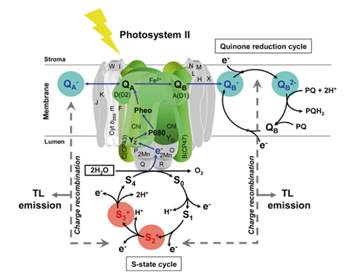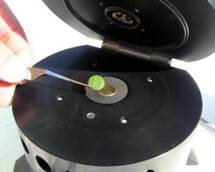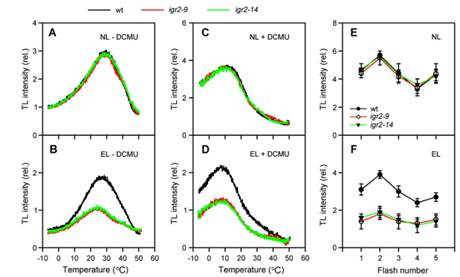TL6000植物热释光测量系统
热释光(Thermoluminescence,缩写TL)是晶体受到辐射照射后,产生了自由电子。这些电子被晶格缺陷俘获而积攒起来,在加热过程中以光形式释放出来。叶绿素热释光则是由于活化能垒在生理温度下限制了诸如电子再结合等暗反应,因此光化学反应中分离的电子对稳定存在于电子载体中。在热刺激下, S2QA-,S2QB- 和 S3QB-电子对的再结合,使PSII中激发的单线态叶绿素分子发出热释光。然后,逐渐升高温度会增加再结合的比率,从而激发不同类型的电子对形成TL谱带。叶绿素热释光能够揭示光合放氧复合物(OEC)稳定性及PSII总体完整性、QB受体损伤及叶绿体内腔 pH值变化等光系统 II的深层运转机理。
TL植物热释光测量系统是目前商用化的叶绿素热释光测量仪器,针对研究PSII能量水平结构进行了专门设计。PSII反应中心光诱导电荷分离导致储存了吸收光能的激发电子对的累积。加热诱导这些激发电子对的重组,从而引发光释放,并在一定温度范围内形成特异性热释光曲线。根据不同释光曲线的形状、峰位和峰值,可以研究分析关于特定激发电子对的能量稳定性及PSII反应中心功能等。TL6000为这一系统的ZX型号,ZD测量范围为-100°C到+200°C,使用范围更宽,可以对低温、高温段热释光进行研究。

应用领域
1、 无损伤测量PSII电子传递
2、 PSII对生物/非生物胁迫与结构修饰的适应和应答
3、 胁迫条件下叶绿体内能量不平衡的敏感性检测
4、 类囊体膜PSII氧化还原反应
5、 基于峰值温度转换,对供体侧与受体侧的氧化还原电位变化进行解释
6、 通过测量热释光震荡模式,指示S状态转换和放氧复合体状态
典型样品
植物碎片
各种微藻
叶绿体悬浮液
类囊体悬浮液
工作原理

热释光(Thermoluminescence,缩写TL)是晶体受到辐射照射后,会产生自由电子,这些电子被晶格缺陷俘获而积攒起来,在加热过程中以光形式释放出来。其基本的实验过程是将叶片快速冷冻到某一温度,之后给叶片一个足够强,但时间尽量短(一般<5µs)的单反转光(single turn-over flash),用于诱导每个PSII反应中心发生仅一次的电荷分离;然后逐渐升温,同时测量叶片放出的热释光,绘制TL谱带。
TL植物光合热释光测量系统使用能量足够强的LED光源,所释放5-10µs的方波脉冲能够饱和所有的PSII反应中心,其温度控制单元可以在降温后,再使样品的温度以0.1℃/sec到1.5℃/sec的速率线性增加。不同的闪光序列及样品处理能够使样品处于不同的能量状态,不同的温度下释放的光能源自光合机构的不同结构。分析释光曲线的形状、峰位和峰值,可以研究分析关于特定激发电子对的能量稳定性及PSII反应中心功能等。
热释光(TL)谱带的来源及意义

不同型号的控温方式与范围
具体型号 | 控温方式 | 控温范围 |
TL 6000/ST标准版 | Peltier控温器+水冷单元 | -25℃到+70℃ |
TL 6000/ET温度扩展版 | 电阻加热器+液氮制冷单元 | -100℃到+200℃ |

系统组成
TL系列植物光合热释光测量系统由3部分组成:主控制分析单元、外部制冷单元、测量室。


主控制分析单元:根据用户定义方案或软件内置的实验程序来执行实验过程并采集数据。彩色显示屏可实时显示测量曲线。
外部制冷单元:
水冷单元(TL 6000/ST标准版配备):包含一个电子控制的抽水泵和内部储水的制冷器,用于测量室降温。

液氮制冷单元(TL 6000/ET温度扩展版配备):将液氮罐通过管路连接到测量室,通过电子控制的低温输出阀可以将测量室温度控制到ZD-100℃。同时也用于测量结束后给测量室降温。
测量室:包括四个关键组成部分:光源、光电倍增管传感器、温度控制器、样品盘。
技术参数
· 温度范围:
TL 6000/ST标准版:-25℃到+70℃
TL 6000/ET温度扩展版:-100℃到+200℃
· 控温模式:线性升温
· ZD线性升温速度:TL 6000/ST标准版1.5ºC/sec,TL 6000/ET温度扩展版1.8ºC/sec
温度调控方式:TL 6000/ST标准版:Peltier控温器+水冷单元;TL 6000/ET温度扩展版:电阻加热器+液氮制冷单元
小采样周期:100ms
过热保护:提供
环境光保护:提供
· 控制模式:手动(恒温);程序设定温度曲线
· 样品盘:镀金铜盘,TL 6000/ST标准版直径14mm,TL 6000/ET温度扩展版直径22mm
· 测量样品:藻类、蓝藻、叶绿体悬浮液,叶片等
· 单反转饱和脉冲:波长lmax=627nm,ZD光强250000µmol(photons).m-2.s-1
· 光化光:波长lmax=627nm,ZD光强2000µmol(photons). m-2.s-1
· 探测传感器:通过软件灵敏控制的光电倍增管
· 光谱响应:300nm-900nm
· 接通延迟:100ms
· 控制:用户可通过专用编程语言自定义程序控制仪器测量过程
· 通讯:RS232串口/USB
· 软件:FluorWin 3.7
· 电源:90V-240V
操作软件与实验结果

典型应用

中科院植物所卢从明研究员是国内将TL热释光技术用于植物光合研究的科学家之一,其领导的团队也一直位于这一研究的国际前沿。上图即为2016年发表的文献,通过测量施加DCMU和不同光照条件的叶绿素热释光曲线,评估谷胱甘肽还原酶2对拟南芥PSII维持功能的作用(Ding,2016)。
产地:欧洲
参考文献:
l OHP1, OHP2, and HCF244 form a transient functional complex with the photosystem II reaction center, Y Li, et al, 2019. Plant Physiology 179, 195–208
l Antimycin A inhibits cytochrome b559-mediated cyclic electron flow within photosystem II, D Takagi, et al, 2019. Photosynthesis Research 139(1–3), 487–498
l 'Birth defects' of photosystem II make it highly susceptible to photodamage during chloroplast biogenesis, D Shevela, et al, 2019. Physiologia Plantarum 166, 165–180
l High light acclimation of Chromera velia points to photoprotective NPQ, E Belgio, et al, 2018. Photosynthesis Research 135(1–3), 263–274
l Comparison of photosynthetic performances of marine picocyanobacteria with different configurations of the oxygen-evolving complex, F Partensky, et al, 2018. Photosynthesis Research 138(1), 57–71
l Diel regulation of photosynthetic activity in the oceanic unicellular diazotrophic cyanobacterium Crocosphaera watsonii WH8501, T Masuda, et al, 2018. Environmental Microbiology 20(2), 546–560
l Glutathione reductase 2 maintains the function of photosystem II in Arabidopsis under excess light, S Ding, et al, 2016. Biochimica et BiophysicaActa (BBA) – Bioenergetics1857(6), 665–677
l Titanium dioxide nanoparticles (100–1000 mg/l) can affect vitamin E response in Arabidopsis thaliana, R Szymańska, et al, 2016. Environmental Pollution 213, 957–965
l The N-terminal sequence of the extrinsic PsbP protein modulates the redox potential of Cyt b559 in photosystem II, T Nishimura, et al, 2016.Sci Rep. 6, 21490.
l The PsbY protein of Arabidopsis Photosystem II is important for the redox control of Cytochrome b 559, L von Sydow, et al, 2016. Biochimica et BiophysicaActa (BBA) – Bioenergetics1857 (9),1524–1533
l Herbicidal effects of harmaline from Peganumharmala on photosynthesis of Chlorella pyrenoidosa: Probed by chlorophyll fluorescence and thermoluminescence, C Deng, et al, 2014. Pesticide Biochemistry and Physiology115, 23–31
l Characterization of photosystem I in rice (Oryza sativa L.) seedlings upon exposure to random positioning machine, B Chen, et al, 2013. Photosynthesis Research116(1), 93–105
l Isochorismate synthase 1 is required for thylakoid organization, optimal plastoquinone redox status, and state transitions in Arabidopsis thaliana, P Gawroński, et al, 2013.Journal of Experimental Botany
l Enhanced sensitivity and characterization of photosystem II in transgenic tobacco plants with decreased chloroplast glutathione reductase under chilling stress, Ding, et al, 2012. Biochimica et BiophysicaActa (BBA) – Bioenergetics1817(11), 1979–1991
l Thermoluminescence. PV Sane, et al, 2012. Photosynthesis
l Analysis of S2QA-charge recombination with the Arrhenius, Eyring and Marcus theories. S Rantamäki, et al, 2011. Journal of Photochemistry and Photobiology B: Biology
l Manganese limitation induces changes in the activity and in the organization of photosynthetic complexes in the cyanobacterium Synechocystis sp. strain PCC 6803. E Salomon, et al, 2011. Plant physiology
l Inhibition of photosynthetic oxygen evolution and electron transfer from the quinone acceptor QA− to QB by iron deficiency. N Msilini, et al, 2011. Photosynthesis research
l Chlorophyll fluorescence emission as a reporter on cold tolerance in Arabidopsis thaliana accessions. A Mishra, et al. Plant Signaling &Behavior, 2011
l Characterization of photosystem II in transgenic tobacco plants with decreased iron superoxide dismutase. Y Zhang, et al, 2011. Biochimica et BiophysicaActa
l Two functional sites of phosphatidylglycerol for regulation of reaction of plastoquinone QB in photosystem II. S Itoh, et al, 2011. Biochimica et BiophysicaActa
l Binding Stoichiometry and Affinity of the Manganese-Stabilizing Protein Affects Redox Reactions on the Oxidizing Side of Photosystem II. JL Roose, et al, 2011. Biochemistry
北京易科泰生态技术有限公司
仪器网(yiqi.com)--仪器行业网络宣传传媒